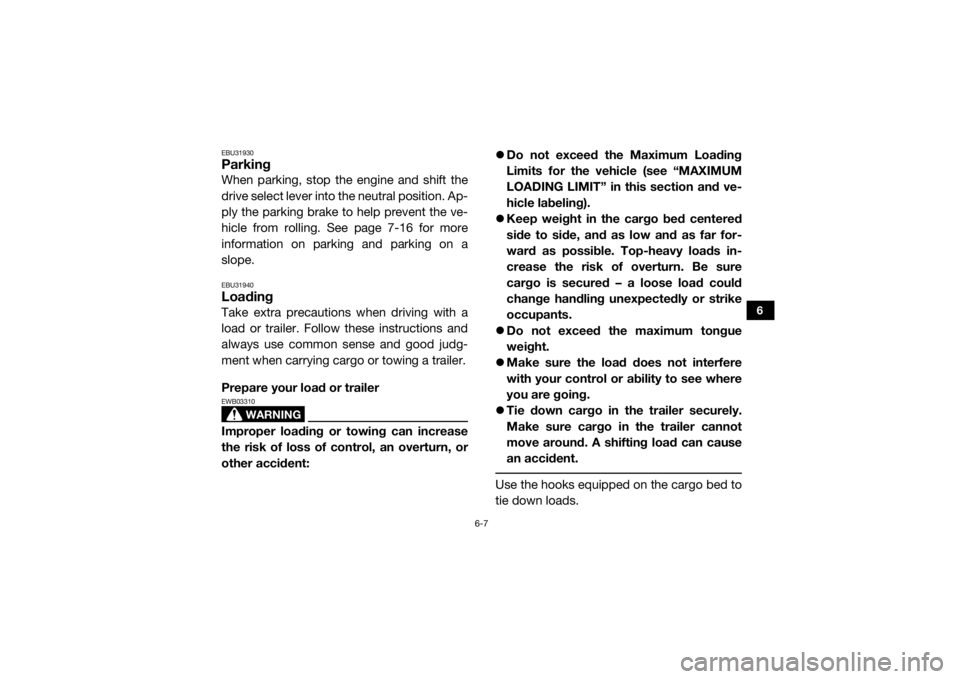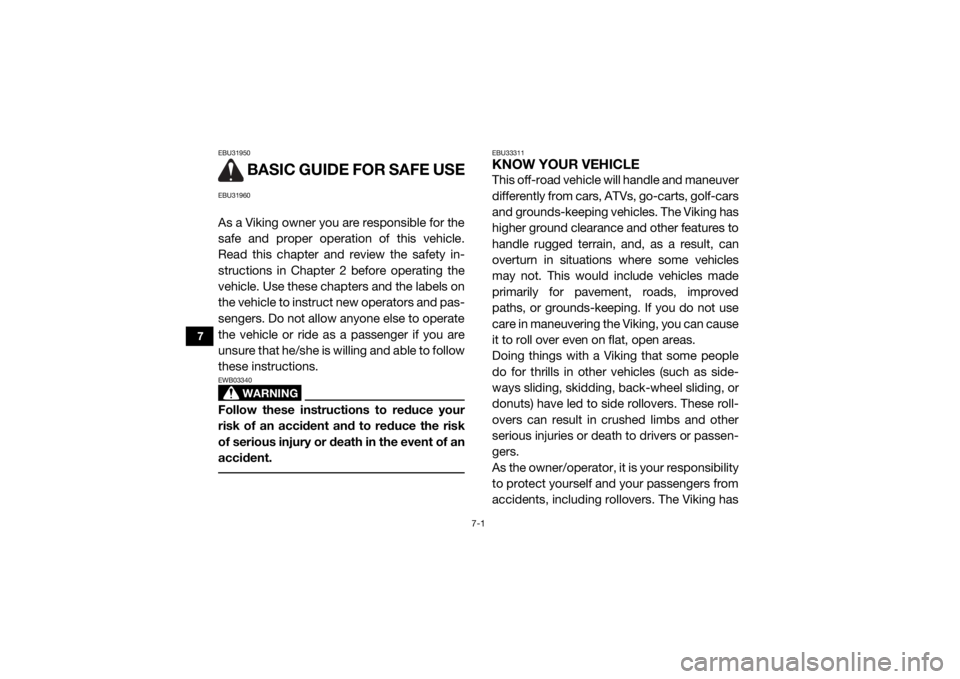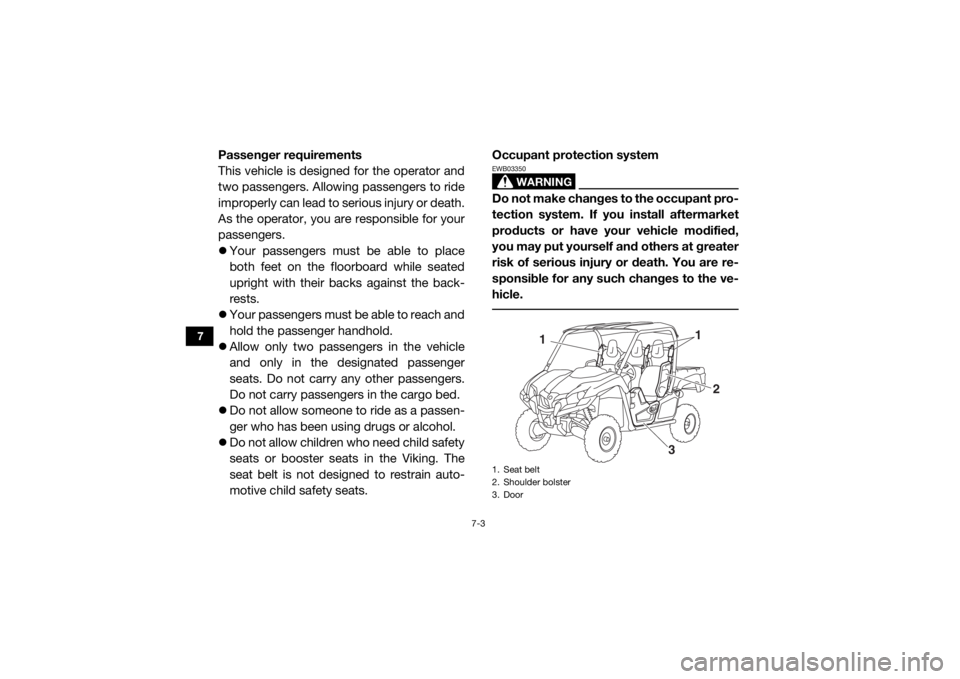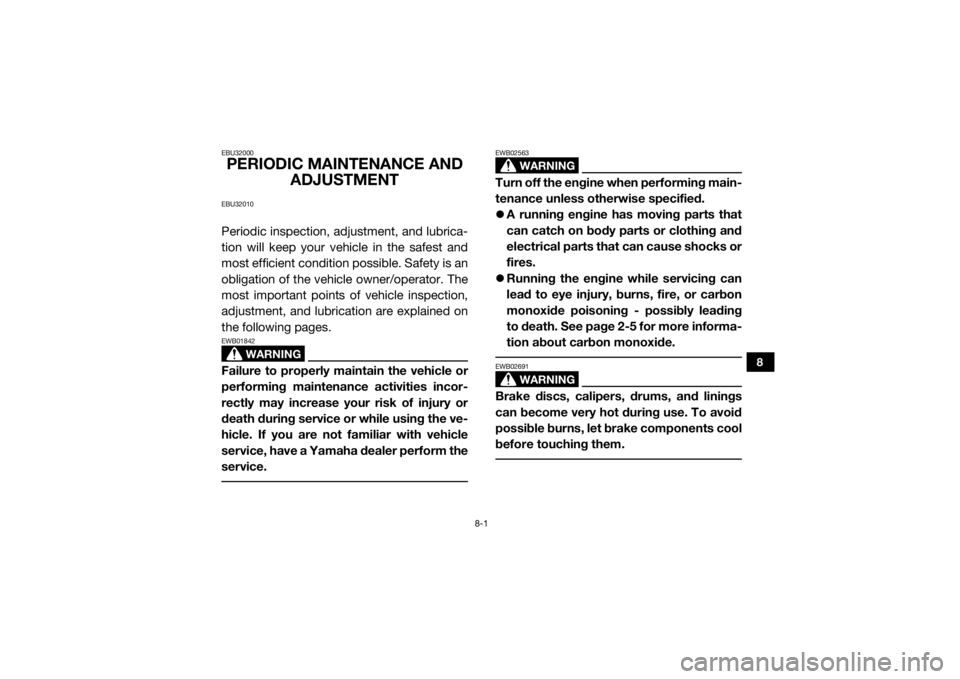Page 77 of 172

6-7
6
EBU31930ParkingWhen parking, stop the engine and shift the
drive select lever into the neutral position. Ap-
ply the parking brake to help prevent the ve-
hicle from rolling. See page 7-16 for more
information on parking and parking on a
slope.EBU31940LoadingTake extra precautions when driving with a
load or trailer. Follow these instructions and
always use common sense and good judg-
ment when carrying cargo or towing a trailer.
Prepare your load or trailer
WARNING
EWB03310Improper loading or towing can increase
the risk of loss of control, an overturn, or
other accident:
Do not exceed the Maximum Loading
Limits for the vehicle (see “MAXIMUM
LOADING LIMIT” in this section and ve-
hicle labeling).
Keep weight in the cargo bed centered
side to side, and as low and as far for-
ward as possible. Top-heavy loads in-
crease the risk of overturn. Be sure
cargo is secured – a loose load could
change handling unexpectedly or strike
occupants.
Do not exceed the maximum tongue
weight.
Make sure the load does not interfere
with your control or ability to see where
you are going.
Tie down cargo in the trailer securely.
Make sure cargo in the trailer cannot
move around. A shifting load can cause
an accident.
Use the hooks equipped on the cargo bed to
tie down loads.
UB427AE0.book Page 7 Monday, May 18, 2015 9:17 AM
Page 78 of 172

6-8
6
Choose a trailer hitch drawbar designed for
use with a 5 cm (2 in) receiver. (See page 4-23
for more information.)
You can measure tongue weight with a bath-
room scale. Put the tongue of the loaded trail-
er on the scale with the tongue at hitch height.
Adjust the load in the trailer, if necessary, to
reduce the weight on hitch. If you are carrying
cargo and towing a trailer, include the tongue
weight in the maximum vehicle load limit.Operating when loaded with cargo or tow-
ing a trailer
Drive more slowly than you would without a
load. The more weight you carry, the slower
you should go. Although conditions vary, it is
good practice to keep the vehicle in low gear
whenever you are carrying heavier loads or
when towing a trailer.
WARNING
EWB03320Carrying loads or towing a trailer can in-
crease the risk of loss of control, an over-
turn, or other accident. To reduce the risk
of an accident:
Reduce speed, operate in low gear only,
and allow more room to stop. A heavier
vehicle takes longer to stop.
Avoid hills and rough terrain. Choose
terrain carefully. Use extreme caution
when towing or carrying a load on in-
clines.
Turn gradually and go slowly.
MAXIMUM LOADING LIMIT
Vehicle loading limit (total weight of cargo,
operator, passengers and accessories and
tongue weight): 411.0 kg (906 lb)
Cargo bed: 272.0 kg (600 lb)
Trailer hitch:Pulling load (total weight of trailer and
cargo): 6664 N (680 kgf, 1500 lbf)
Tongue weight (vertical weight on trailer
hitch point): 490 N (50 kgf, 110 lbf)
UB427AE0.book Page 8 Monday, May 18, 2015 9:17 AM
Page 79 of 172
6-9
6
Pulling something other than a trailer
Yamaha recommends that loads be trans-
ported in the bed or in a trailer. If you need to
move an object a short distance use a winch
and follow the winch manufacturer’s instruc-
tions.
If you choose to use something other than a
winch use extreme caution, follow the manu-
facturer’s instructions for that product, and
only attach to the hitch or hitch bracket of the
Viking. WARNING! Improperly pulling can
cause serious injury or death. Never ex-
ceed the pulling load limit of the Viking.
Avoid pulling on inclines.
[EWB03330]
Pulling objects on the ground can be more
hazardous than pulling a trailer. It may be dif-
ficult to predict how the load will affect vehicle
operation. That effect could also change de-
pending upon terrain or what obstacles might
be in the object’s path.UB427AE0.book Page 9 Monday, May 18, 2015 9:17 AM
Page 80 of 172

7-1
7
EBU31950
BASIC GUIDE FOR SAFE USE
EBU31960As a Viking owner you are responsible for the
safe and proper operation of this vehicle.
Read this chapter and review the safety in-
structions in Chapter 2 before operating the
vehicle. Use these chapters and the labels on
the vehicle to instruct new operators and pas-
sengers. Do not allow anyone else to operate
the vehicle or ride as a passenger if you are
unsure that he/she is willing and able to follow
these instructions.
WARNING
EWB03340Follow these instructions to reduce your
risk of an accident and to reduce the risk
of serious injury or death in the event of an
accident.
EBU33311KNOW YOUR VEHICLEThis off-road vehicle will handle and maneuver
differently from cars, ATVs, go-carts, golf-cars
and grounds-keeping vehicles. The Viking has
higher ground clearance and other features to
handle rugged terrain, and, as a result, can
overturn in situations where some vehicles
may not. This would include vehicles made
primarily for pavement, roads, improved
paths, or grounds-keeping. If you do not use
care in maneuvering the Viking, you can cause
it to roll over even on flat, open areas.
Doing things with a Viking that some people
do for thrills in other vehicles (such as side-
ways sliding, skidding, back-wheel sliding, or
donuts) have led to side rollovers. These roll-
overs can result in crushed limbs and other
serious injuries or death to drivers or passen-
gers.
As the owner/operator, it is your responsibility
to protect yourself and your passengers from
accidents, including rollovers. The Viking has
UB427AE0.book Page 1 Monday, May 18, 2015 9:17 AM
Page 82 of 172

7-3
7
Passenger requirements
This vehicle is designed for the operator and
two passengers. Allowing passengers to ride
improperly can lead to serious injury or death.
As the operator, you are responsible for your
passengers.
Your passengers must be able to place
both feet on the floorboard while seated
upright with their backs against the back-
rests.
Your passengers must be able to reach and
hold the passenger handhold.
Allow only two passengers in the vehicle
and only in the designated passenger
seats. Do not carry any other passengers.
Do not carry passengers in the cargo bed.
Do not allow someone to ride as a passen-
ger who has been using drugs or alcohol.
Do not allow children who need child safety
seats or booster seats in the Viking. The
seat belt is not designed to restrain auto-
motive child safety seats. Occupant protection system
WARNING
EWB03350Do not make changes to the occupant pro-
tection system. If you install aftermarket
products or have your vehicle modified,
you may put yourself and others at greater
risk of serious injury or death. You are re-
sponsible for any such changes to the ve-
hicle. 1. Seat belt
2. Shoulder bolster
3. Door
2
3
1
1
UB427AE0.book Page 3 Monday, May 18, 2015 9:17 AM
Page 101 of 172

8-1
8
EBU32000PERIODIC MAINTENANCE AND ADJUSTMENTEBU32010Periodic inspection, adjustment, and lubrica-
tion will keep your vehicle in the safest and
most efficient condition possible. Safety is an
obligation of the vehicle owner/operator. The
most important points of vehicle inspection,
adjustment, and lubrication are explained on
the following pages.
WARNING
EWB01842Failure to properly maintain the vehicle or
performing maintenance activities incor-
rectly may increase your risk of injury or
death during service or while using the ve-
hicle. If you are not familiar with vehicle
service, have a Yamaha dealer perform the
service.
WARNING
EWB02563Turn off the engine when performing main-
tenance unless otherwise specified.
A running engine has moving parts that
can catch on body parts or clothing and
electrical parts that can cause shocks or
fires.
Running the engine while servicing can
lead to eye injury, burns, fire, or carbon
monoxide poisoning - possibly leading
to death. See page 2-5 for more informa-
tion about carbon monoxide.
WARNING
EWB02691Brake discs, calipers, drums, and linings
can become very hot during use. To avoid
possible burns, let brake components cool
before touching them.
UB427AE0.book Page 1 Monday, May 18, 2015 9:17 AM
Page 127 of 172
8-27
8
8. Wash the sponge material gently butthoroughly in parts cleaning solvent.
WARNING! Using gasoline or other flammable solvents to clean the air fil-
ter element can cause a fire or explo-
sion, which could lead to serious
injury.
[EWB03360]
9. Squeeze the excess solvent out of the
sponge material. NOTICE: Do not twist
the sponge material when squeezing
it.
[ECB00442]
10. Wash the sponge material in warm soapy
water to remove remaining solvent, then
rinse thoroughly with plain warm water.
11. Squeeze excess water out of the sponge
material. NOTICE: Do not twist the
sponge material when squeezing it.
[ECB00442]
12. Allow the sponge material to dry thor- oughly. Inspect the sponge material and
replace it if damaged.
1. Air filter element holder
2. Sponge material
3. Air filter frame
3
2
1
UB427AE0.book Page 27 Monday, May 18, 2015 9:17 AM
Page 130 of 172
8-30
8
EBU32440V-belt case drain plugThe V-belt case drain plug is located under
the cargo bed. (See page 4-22 for cargo bed
lifting and lowering procedures.)
After riding in water deep enough to allow wa-
ter to enter the V-belt case, remove the drain
plug to drain any water from the case.
If water drains from the V-belt case after re-
moving the drain plug, have a Yamaha dealer
inspect the vehicle, as the water may affect
other engine parts.
EBU32450Cleaning the spark arrester
WARNING
EWB03370Hot exhaust system may cause burns. To
avoid burns or fires, make sure that the en-
gine is stopped and the exhaust system is
cool before cleaning the spark arrester. Do
not start the engine while cleaning the ex-
haust system. 1. Remove the tailpipe bolts.
1. Air duct check hose
1
1. V-belt case drain plug
1
UB427AE0.book Page 30 Monday, May 18, 2015 9:17 AM